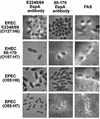Polymorphisms within EspA filaments of enteropathogenic and enterohemorrhagic Escherichia coli
- PMID: 12654853
- PMCID: PMC152064
- DOI: 10.1128/IAI.71.4.2262-2265.2003
Polymorphisms within EspA filaments of enteropathogenic and enterohemorrhagic Escherichia coli
Abstract
Enteropathogenic Escherichia coli (EPEC) and enterohemorrhagic E. coli (EHEC) possess a filamentous type III secretion system (TTSS) employed to deliver effector proteins into host cells. EspA is a type III secreted protein which forms the filamentous extension to the TTSS and which interacts with host cells during early stages of attaching and effacing (A/E) lesion formation. By immunofluorescence, a polyclonal antibody previously raised to EspA from EPEC strain E2348/69 (O127:H6) stained approximately 12-nm-diameter EspA filaments produced by this strain but did not stain similar filaments produced by EHEC serotype O157:H7. Similarly, an antibody that we subsequently raised to EHEC strain 85-170 (O157:H7) EspA stained approximately 12-nm-diameter EspA filaments produced by strain 85-170 but did not stain E2348/69 EspA filaments. Given such heterogeneity between EPEC and EHEC EspA filaments, we examined polymorphisms of functional EspA filaments among different EPEC and EHEC serotypes. With use of the EPEC EspA antiserum, EspA filaments were observed only with EPEC serotypes O127:H6 and O55:H6, serotypes which encode an identical EspA protein. When stained with the EHEC EspA antiserum, EspA filaments were detected only on EHEC strains belonging to serotype O157:H7; the EHEC antiserum did, however, stain EspA filaments produced by the closely related EPEC serotype O55:H7 but not filaments of any other EPEC serotype tested. Such polymorphisms among functional EspA filaments of EPEC and EHEC would be expected to have important implications for the development of broad-range EspA-based vaccines.
Figures


References
-
- China, B., F. Goffaux, V. Pirson, and J. Mainil. 1999. Comparison of eae, tir, espA and espB genes of bovine and human attaching and effacing Escherichia coli by multiplex polymerase chain reaction. FEMS Microbiol. Lett. 178:177-182. - PubMed
-
- Daniell, S. J., N. Takahashi, R. Wilson, D. Friedberg, I. Rosenshine, F. P. Booy, R. K. Shaw, S. Knutton, G. Frankel, and S. Aizawa. 2001. The filamentous type III secretion translocon of enteropathogenic Escherichia coli. Cell. Microbiol. 3:865-871. - PubMed
-
- Ebel, F., T. Podzadel, M. Rohde, A. U. Kresse, S. Kramer, C. Deibel, C. A. Guzman, and T. Chakraborty. 1998. Initial binding of Shiga toxin-producing Escherichia coli to host cells and subsequent induction of actin rearrangements depend on filamentous EspA-containing surface appendages. Mol. Microbiol. 30:147-161. - PubMed
Publication types
MeSH terms
Substances
LinkOut - more resources
Full Text Sources
Other Literature Sources

